Credit Analysis And Lending Management
VerifiedAdded on 2023/01/16
|12
|3352
|92
AI Summary
This study material discusses the cases of Bank PERTAMINA Malaysia v. Blue Valley Plantation Bhd & ORS and Bank Bumiputra Malaysia Bhd. Kuala Terengganu v. Mae Perkayuan Sdn. Bhd. It explores the topics of credit analysis, lending management, collateral, conditions, and capacity. The cases involve disputes over loan agreements, breach of contract, and fraudulent practices. The material provides insights into the importance of conducting thorough credit analysis and evaluating the borrower's capacity to repay the loan.
Contribute Materials
Your contribution can guide someone’s learning journey. Share your
documents today.
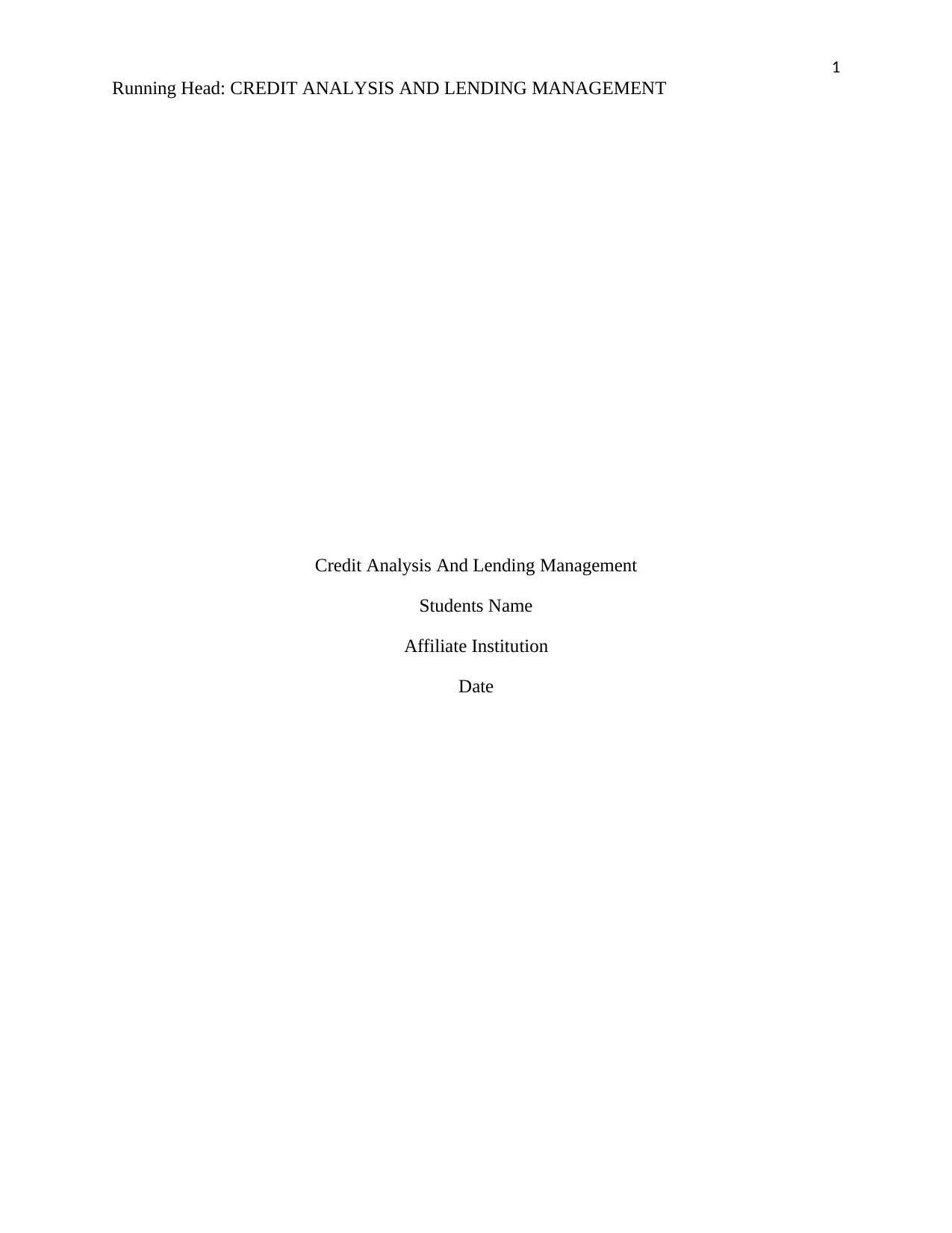
1
Running Head: CREDIT ANALYSIS AND LENDING MANAGEMENT
Credit Analysis And Lending Management
Students Name
Affiliate Institution
Date
Running Head: CREDIT ANALYSIS AND LENDING MANAGEMENT
Credit Analysis And Lending Management
Students Name
Affiliate Institution
Date
Secure Best Marks with AI Grader
Need help grading? Try our AI Grader for instant feedback on your assignments.
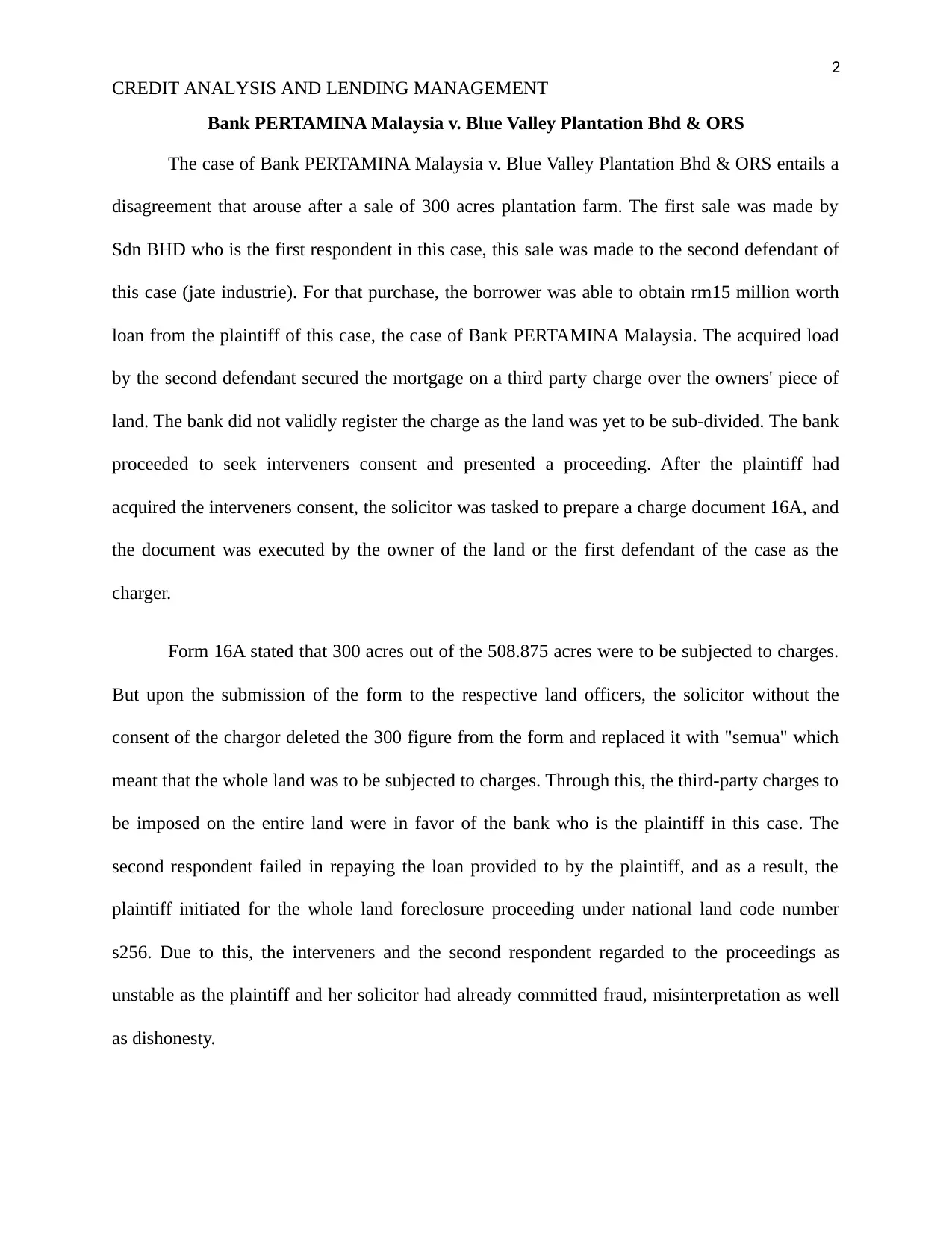
2
CREDIT ANALYSIS AND LENDING MANAGEMENT
Bank PERTAMINA Malaysia v. Blue Valley Plantation Bhd & ORS
The case of Bank PERTAMINA Malaysia v. Blue Valley Plantation Bhd & ORS entails a
disagreement that arouse after a sale of 300 acres plantation farm. The first sale was made by
Sdn BHD who is the first respondent in this case, this sale was made to the second defendant of
this case (jate industrie). For that purchase, the borrower was able to obtain rm15 million worth
loan from the plaintiff of this case, the case of Bank PERTAMINA Malaysia. The acquired load
by the second defendant secured the mortgage on a third party charge over the owners' piece of
land. The bank did not validly register the charge as the land was yet to be sub-divided. The bank
proceeded to seek interveners consent and presented a proceeding. After the plaintiff had
acquired the interveners consent, the solicitor was tasked to prepare a charge document 16A, and
the document was executed by the owner of the land or the first defendant of the case as the
charger.
Form 16A stated that 300 acres out of the 508.875 acres were to be subjected to charges.
But upon the submission of the form to the respective land officers, the solicitor without the
consent of the chargor deleted the 300 figure from the form and replaced it with "semua" which
meant that the whole land was to be subjected to charges. Through this, the third-party charges to
be imposed on the entire land were in favor of the bank who is the plaintiff in this case. The
second respondent failed in repaying the loan provided to by the plaintiff, and as a result, the
plaintiff initiated for the whole land foreclosure proceeding under national land code number
s256. Due to this, the interveners and the second respondent regarded to the proceedings as
unstable as the plaintiff and her solicitor had already committed fraud, misinterpretation as well
as dishonesty.
CREDIT ANALYSIS AND LENDING MANAGEMENT
Bank PERTAMINA Malaysia v. Blue Valley Plantation Bhd & ORS
The case of Bank PERTAMINA Malaysia v. Blue Valley Plantation Bhd & ORS entails a
disagreement that arouse after a sale of 300 acres plantation farm. The first sale was made by
Sdn BHD who is the first respondent in this case, this sale was made to the second defendant of
this case (jate industrie). For that purchase, the borrower was able to obtain rm15 million worth
loan from the plaintiff of this case, the case of Bank PERTAMINA Malaysia. The acquired load
by the second defendant secured the mortgage on a third party charge over the owners' piece of
land. The bank did not validly register the charge as the land was yet to be sub-divided. The bank
proceeded to seek interveners consent and presented a proceeding. After the plaintiff had
acquired the interveners consent, the solicitor was tasked to prepare a charge document 16A, and
the document was executed by the owner of the land or the first defendant of the case as the
charger.
Form 16A stated that 300 acres out of the 508.875 acres were to be subjected to charges.
But upon the submission of the form to the respective land officers, the solicitor without the
consent of the chargor deleted the 300 figure from the form and replaced it with "semua" which
meant that the whole land was to be subjected to charges. Through this, the third-party charges to
be imposed on the entire land were in favor of the bank who is the plaintiff in this case. The
second respondent failed in repaying the loan provided to by the plaintiff, and as a result, the
plaintiff initiated for the whole land foreclosure proceeding under national land code number
s256. Due to this, the interveners and the second respondent regarded to the proceedings as
unstable as the plaintiff and her solicitor had already committed fraud, misinterpretation as well
as dishonesty.
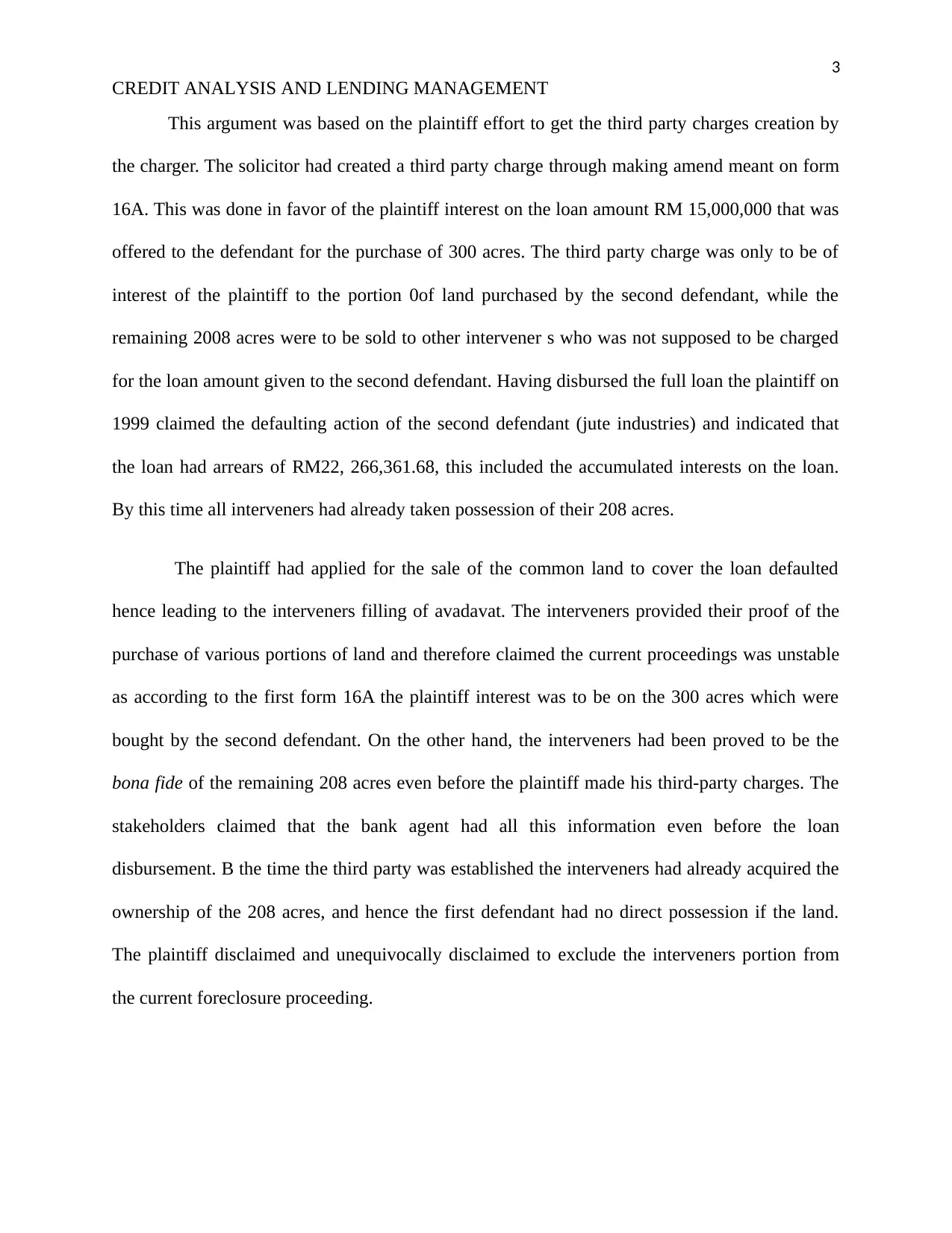
3
CREDIT ANALYSIS AND LENDING MANAGEMENT
This argument was based on the plaintiff effort to get the third party charges creation by
the charger. The solicitor had created a third party charge through making amend meant on form
16A. This was done in favor of the plaintiff interest on the loan amount RM 15,000,000 that was
offered to the defendant for the purchase of 300 acres. The third party charge was only to be of
interest of the plaintiff to the portion 0of land purchased by the second defendant, while the
remaining 2008 acres were to be sold to other intervener s who was not supposed to be charged
for the loan amount given to the second defendant. Having disbursed the full loan the plaintiff on
1999 claimed the defaulting action of the second defendant (jute industries) and indicated that
the loan had arrears of RM22, 266,361.68, this included the accumulated interests on the loan.
By this time all interveners had already taken possession of their 208 acres.
The plaintiff had applied for the sale of the common land to cover the loan defaulted
hence leading to the interveners filling of avadavat. The interveners provided their proof of the
purchase of various portions of land and therefore claimed the current proceedings was unstable
as according to the first form 16A the plaintiff interest was to be on the 300 acres which were
bought by the second defendant. On the other hand, the interveners had been proved to be the
bona fide of the remaining 208 acres even before the plaintiff made his third-party charges. The
stakeholders claimed that the bank agent had all this information even before the loan
disbursement. B the time the third party was established the interveners had already acquired the
ownership of the 208 acres, and hence the first defendant had no direct possession if the land.
The plaintiff disclaimed and unequivocally disclaimed to exclude the interveners portion from
the current foreclosure proceeding.
CREDIT ANALYSIS AND LENDING MANAGEMENT
This argument was based on the plaintiff effort to get the third party charges creation by
the charger. The solicitor had created a third party charge through making amend meant on form
16A. This was done in favor of the plaintiff interest on the loan amount RM 15,000,000 that was
offered to the defendant for the purchase of 300 acres. The third party charge was only to be of
interest of the plaintiff to the portion 0of land purchased by the second defendant, while the
remaining 2008 acres were to be sold to other intervener s who was not supposed to be charged
for the loan amount given to the second defendant. Having disbursed the full loan the plaintiff on
1999 claimed the defaulting action of the second defendant (jute industries) and indicated that
the loan had arrears of RM22, 266,361.68, this included the accumulated interests on the loan.
By this time all interveners had already taken possession of their 208 acres.
The plaintiff had applied for the sale of the common land to cover the loan defaulted
hence leading to the interveners filling of avadavat. The interveners provided their proof of the
purchase of various portions of land and therefore claimed the current proceedings was unstable
as according to the first form 16A the plaintiff interest was to be on the 300 acres which were
bought by the second defendant. On the other hand, the interveners had been proved to be the
bona fide of the remaining 208 acres even before the plaintiff made his third-party charges. The
stakeholders claimed that the bank agent had all this information even before the loan
disbursement. B the time the third party was established the interveners had already acquired the
ownership of the 208 acres, and hence the first defendant had no direct possession if the land.
The plaintiff disclaimed and unequivocally disclaimed to exclude the interveners portion from
the current foreclosure proceeding.
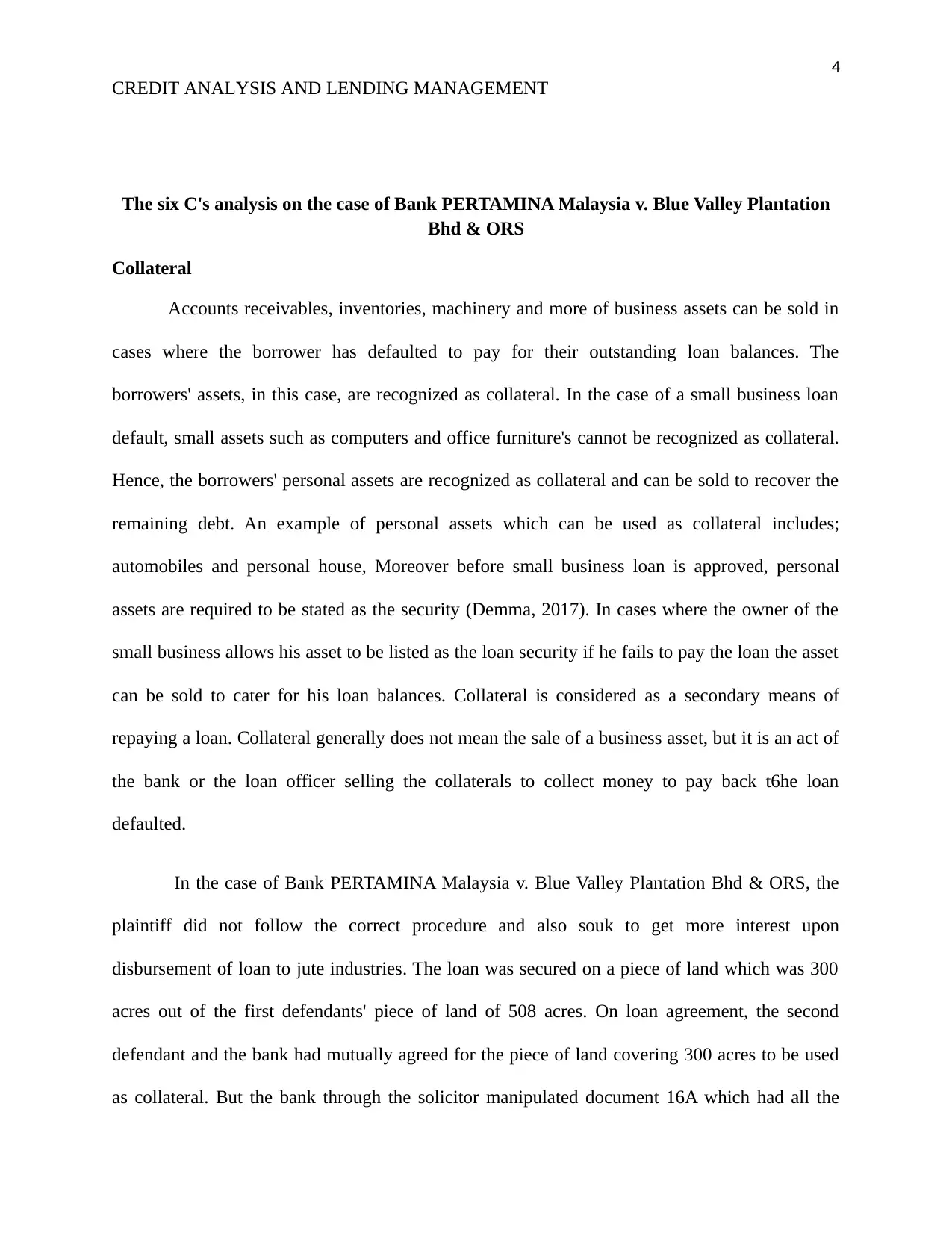
4
CREDIT ANALYSIS AND LENDING MANAGEMENT
The six C's analysis on the case of Bank PERTAMINA Malaysia v. Blue Valley Plantation
Bhd & ORS
Collateral
Accounts receivables, inventories, machinery and more of business assets can be sold in
cases where the borrower has defaulted to pay for their outstanding loan balances. The
borrowers' assets, in this case, are recognized as collateral. In the case of a small business loan
default, small assets such as computers and office furniture's cannot be recognized as collateral.
Hence, the borrowers' personal assets are recognized as collateral and can be sold to recover the
remaining debt. An example of personal assets which can be used as collateral includes;
automobiles and personal house, Moreover before small business loan is approved, personal
assets are required to be stated as the security (Demma, 2017). In cases where the owner of the
small business allows his asset to be listed as the loan security if he fails to pay the loan the asset
can be sold to cater for his loan balances. Collateral is considered as a secondary means of
repaying a loan. Collateral generally does not mean the sale of a business asset, but it is an act of
the bank or the loan officer selling the collaterals to collect money to pay back t6he loan
defaulted.
In the case of Bank PERTAMINA Malaysia v. Blue Valley Plantation Bhd & ORS, the
plaintiff did not follow the correct procedure and also souk to get more interest upon
disbursement of loan to jute industries. The loan was secured on a piece of land which was 300
acres out of the first defendants' piece of land of 508 acres. On loan agreement, the second
defendant and the bank had mutually agreed for the piece of land covering 300 acres to be used
as collateral. But the bank through the solicitor manipulated document 16A which had all the
CREDIT ANALYSIS AND LENDING MANAGEMENT
The six C's analysis on the case of Bank PERTAMINA Malaysia v. Blue Valley Plantation
Bhd & ORS
Collateral
Accounts receivables, inventories, machinery and more of business assets can be sold in
cases where the borrower has defaulted to pay for their outstanding loan balances. The
borrowers' assets, in this case, are recognized as collateral. In the case of a small business loan
default, small assets such as computers and office furniture's cannot be recognized as collateral.
Hence, the borrowers' personal assets are recognized as collateral and can be sold to recover the
remaining debt. An example of personal assets which can be used as collateral includes;
automobiles and personal house, Moreover before small business loan is approved, personal
assets are required to be stated as the security (Demma, 2017). In cases where the owner of the
small business allows his asset to be listed as the loan security if he fails to pay the loan the asset
can be sold to cater for his loan balances. Collateral is considered as a secondary means of
repaying a loan. Collateral generally does not mean the sale of a business asset, but it is an act of
the bank or the loan officer selling the collaterals to collect money to pay back t6he loan
defaulted.
In the case of Bank PERTAMINA Malaysia v. Blue Valley Plantation Bhd & ORS, the
plaintiff did not follow the correct procedure and also souk to get more interest upon
disbursement of loan to jute industries. The loan was secured on a piece of land which was 300
acres out of the first defendants' piece of land of 508 acres. On loan agreement, the second
defendant and the bank had mutually agreed for the piece of land covering 300 acres to be used
as collateral. But the bank through the solicitor manipulated document 16A which had all the
Paraphrase This Document
Need a fresh take? Get an instant paraphrase of this document with our AI Paraphraser
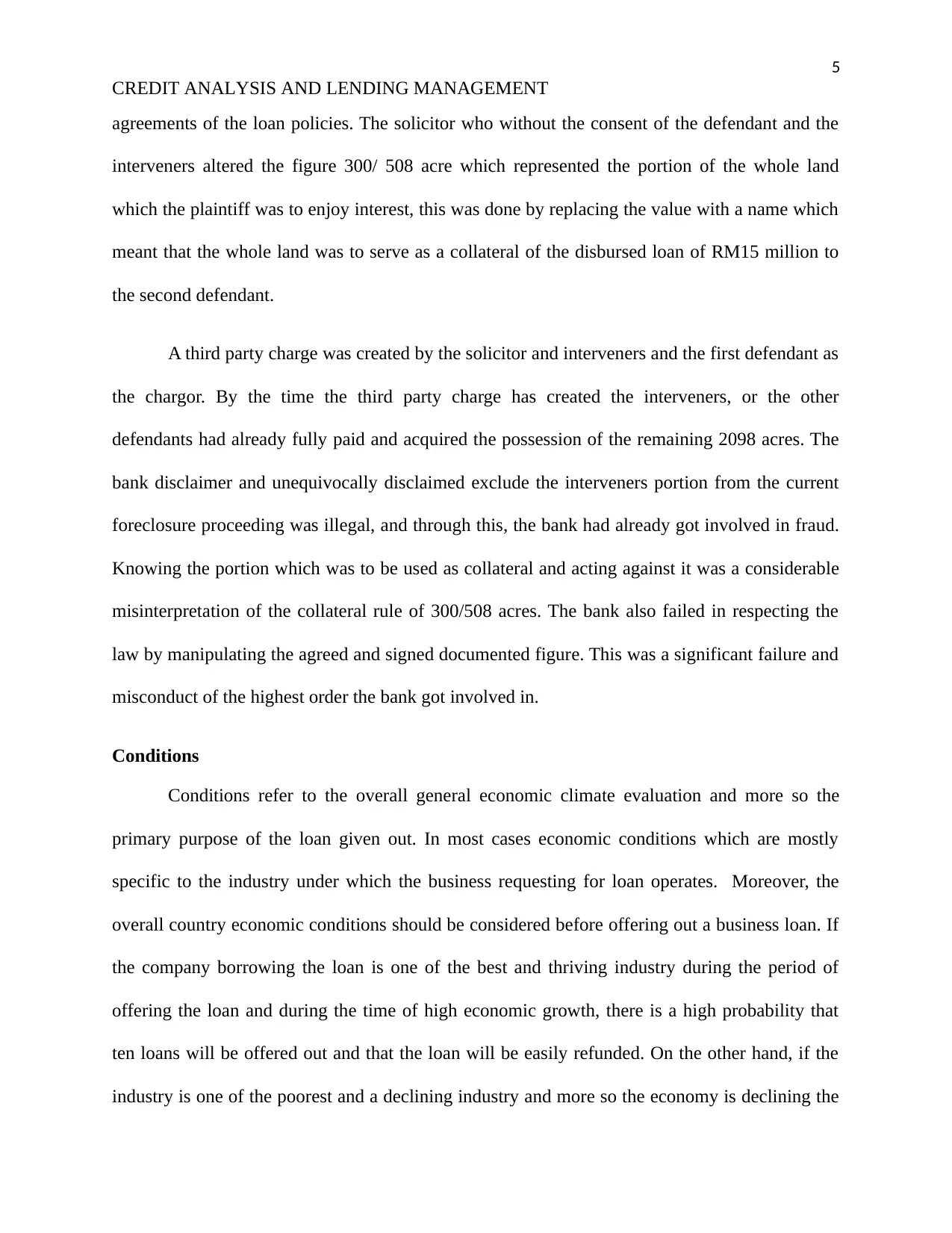
5
CREDIT ANALYSIS AND LENDING MANAGEMENT
agreements of the loan policies. The solicitor who without the consent of the defendant and the
interveners altered the figure 300/ 508 acre which represented the portion of the whole land
which the plaintiff was to enjoy interest, this was done by replacing the value with a name which
meant that the whole land was to serve as a collateral of the disbursed loan of RM15 million to
the second defendant.
A third party charge was created by the solicitor and interveners and the first defendant as
the chargor. By the time the third party charge has created the interveners, or the other
defendants had already fully paid and acquired the possession of the remaining 2098 acres. The
bank disclaimer and unequivocally disclaimed exclude the interveners portion from the current
foreclosure proceeding was illegal, and through this, the bank had already got involved in fraud.
Knowing the portion which was to be used as collateral and acting against it was a considerable
misinterpretation of the collateral rule of 300/508 acres. The bank also failed in respecting the
law by manipulating the agreed and signed documented figure. This was a significant failure and
misconduct of the highest order the bank got involved in.
Conditions
Conditions refer to the overall general economic climate evaluation and more so the
primary purpose of the loan given out. In most cases economic conditions which are mostly
specific to the industry under which the business requesting for loan operates. Moreover, the
overall country economic conditions should be considered before offering out a business loan. If
the company borrowing the loan is one of the best and thriving industry during the period of
offering the loan and during the time of high economic growth, there is a high probability that
ten loans will be offered out and that the loan will be easily refunded. On the other hand, if the
industry is one of the poorest and a declining industry and more so the economy is declining the
CREDIT ANALYSIS AND LENDING MANAGEMENT
agreements of the loan policies. The solicitor who without the consent of the defendant and the
interveners altered the figure 300/ 508 acre which represented the portion of the whole land
which the plaintiff was to enjoy interest, this was done by replacing the value with a name which
meant that the whole land was to serve as a collateral of the disbursed loan of RM15 million to
the second defendant.
A third party charge was created by the solicitor and interveners and the first defendant as
the chargor. By the time the third party charge has created the interveners, or the other
defendants had already fully paid and acquired the possession of the remaining 2098 acres. The
bank disclaimer and unequivocally disclaimed exclude the interveners portion from the current
foreclosure proceeding was illegal, and through this, the bank had already got involved in fraud.
Knowing the portion which was to be used as collateral and acting against it was a considerable
misinterpretation of the collateral rule of 300/508 acres. The bank also failed in respecting the
law by manipulating the agreed and signed documented figure. This was a significant failure and
misconduct of the highest order the bank got involved in.
Conditions
Conditions refer to the overall general economic climate evaluation and more so the
primary purpose of the loan given out. In most cases economic conditions which are mostly
specific to the industry under which the business requesting for loan operates. Moreover, the
overall country economic conditions should be considered before offering out a business loan. If
the company borrowing the loan is one of the best and thriving industry during the period of
offering the loan and during the time of high economic growth, there is a high probability that
ten loans will be offered out and that the loan will be easily refunded. On the other hand, if the
industry is one of the poorest and a declining industry and more so the economy is declining the
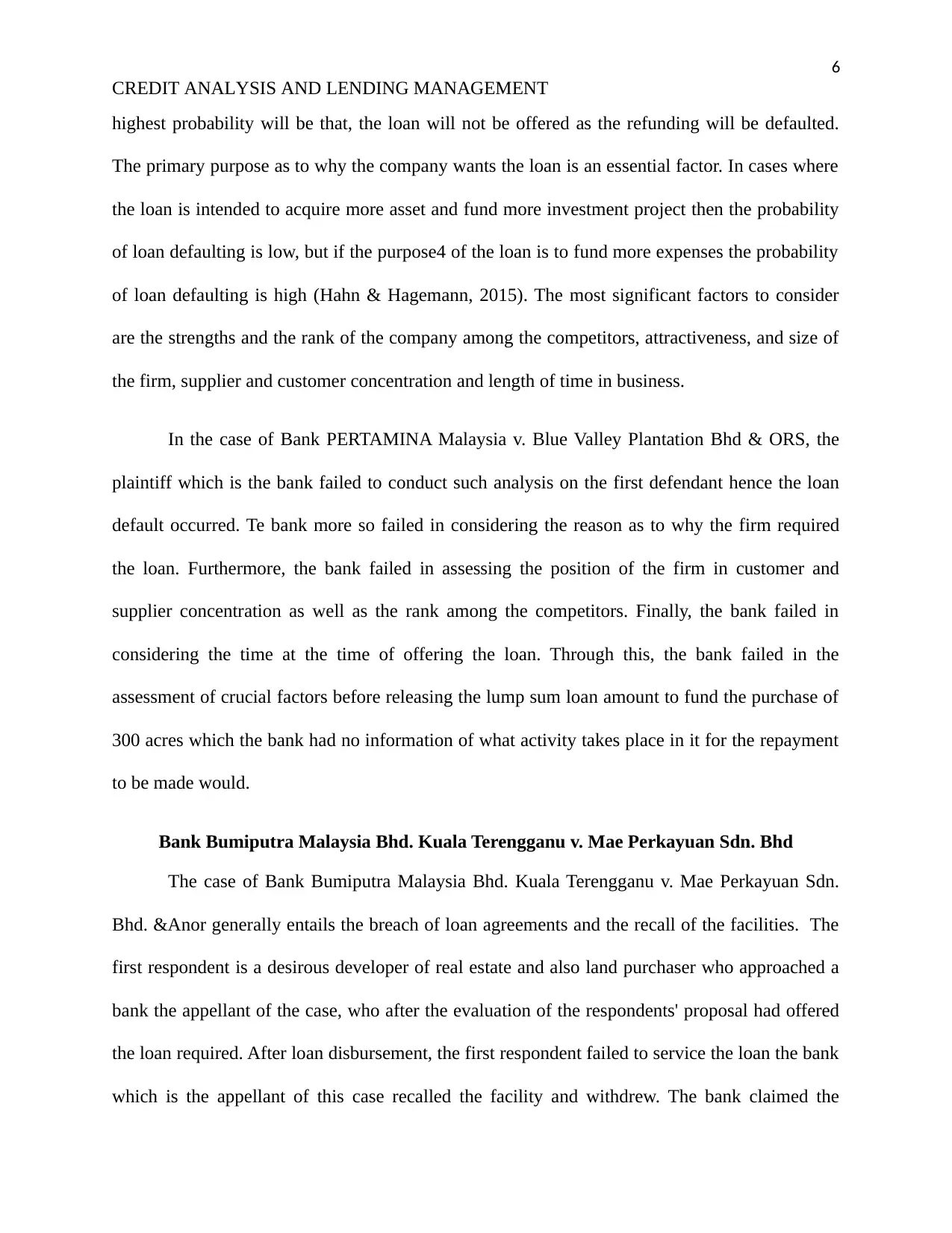
6
CREDIT ANALYSIS AND LENDING MANAGEMENT
highest probability will be that, the loan will not be offered as the refunding will be defaulted.
The primary purpose as to why the company wants the loan is an essential factor. In cases where
the loan is intended to acquire more asset and fund more investment project then the probability
of loan defaulting is low, but if the purpose4 of the loan is to fund more expenses the probability
of loan defaulting is high (Hahn & Hagemann, 2015). The most significant factors to consider
are the strengths and the rank of the company among the competitors, attractiveness, and size of
the firm, supplier and customer concentration and length of time in business.
In the case of Bank PERTAMINA Malaysia v. Blue Valley Plantation Bhd & ORS, the
plaintiff which is the bank failed to conduct such analysis on the first defendant hence the loan
default occurred. Te bank more so failed in considering the reason as to why the firm required
the loan. Furthermore, the bank failed in assessing the position of the firm in customer and
supplier concentration as well as the rank among the competitors. Finally, the bank failed in
considering the time at the time of offering the loan. Through this, the bank failed in the
assessment of crucial factors before releasing the lump sum loan amount to fund the purchase of
300 acres which the bank had no information of what activity takes place in it for the repayment
to be made would.
Bank Bumiputra Malaysia Bhd. Kuala Terengganu v. Mae Perkayuan Sdn. Bhd
The case of Bank Bumiputra Malaysia Bhd. Kuala Terengganu v. Mae Perkayuan Sdn.
Bhd. &Anor generally entails the breach of loan agreements and the recall of the facilities. The
first respondent is a desirous developer of real estate and also land purchaser who approached a
bank the appellant of the case, who after the evaluation of the respondents' proposal had offered
the loan required. After loan disbursement, the first respondent failed to service the loan the bank
which is the appellant of this case recalled the facility and withdrew. The bank claimed the
CREDIT ANALYSIS AND LENDING MANAGEMENT
highest probability will be that, the loan will not be offered as the refunding will be defaulted.
The primary purpose as to why the company wants the loan is an essential factor. In cases where
the loan is intended to acquire more asset and fund more investment project then the probability
of loan defaulting is low, but if the purpose4 of the loan is to fund more expenses the probability
of loan defaulting is high (Hahn & Hagemann, 2015). The most significant factors to consider
are the strengths and the rank of the company among the competitors, attractiveness, and size of
the firm, supplier and customer concentration and length of time in business.
In the case of Bank PERTAMINA Malaysia v. Blue Valley Plantation Bhd & ORS, the
plaintiff which is the bank failed to conduct such analysis on the first defendant hence the loan
default occurred. Te bank more so failed in considering the reason as to why the firm required
the loan. Furthermore, the bank failed in assessing the position of the firm in customer and
supplier concentration as well as the rank among the competitors. Finally, the bank failed in
considering the time at the time of offering the loan. Through this, the bank failed in the
assessment of crucial factors before releasing the lump sum loan amount to fund the purchase of
300 acres which the bank had no information of what activity takes place in it for the repayment
to be made would.
Bank Bumiputra Malaysia Bhd. Kuala Terengganu v. Mae Perkayuan Sdn. Bhd
The case of Bank Bumiputra Malaysia Bhd. Kuala Terengganu v. Mae Perkayuan Sdn.
Bhd. &Anor generally entails the breach of loan agreements and the recall of the facilities. The
first respondent is a desirous developer of real estate and also land purchaser who approached a
bank the appellant of the case, who after the evaluation of the respondents' proposal had offered
the loan required. After loan disbursement, the first respondent failed to service the loan the bank
which is the appellant of this case recalled the facility and withdrew. The bank claimed the
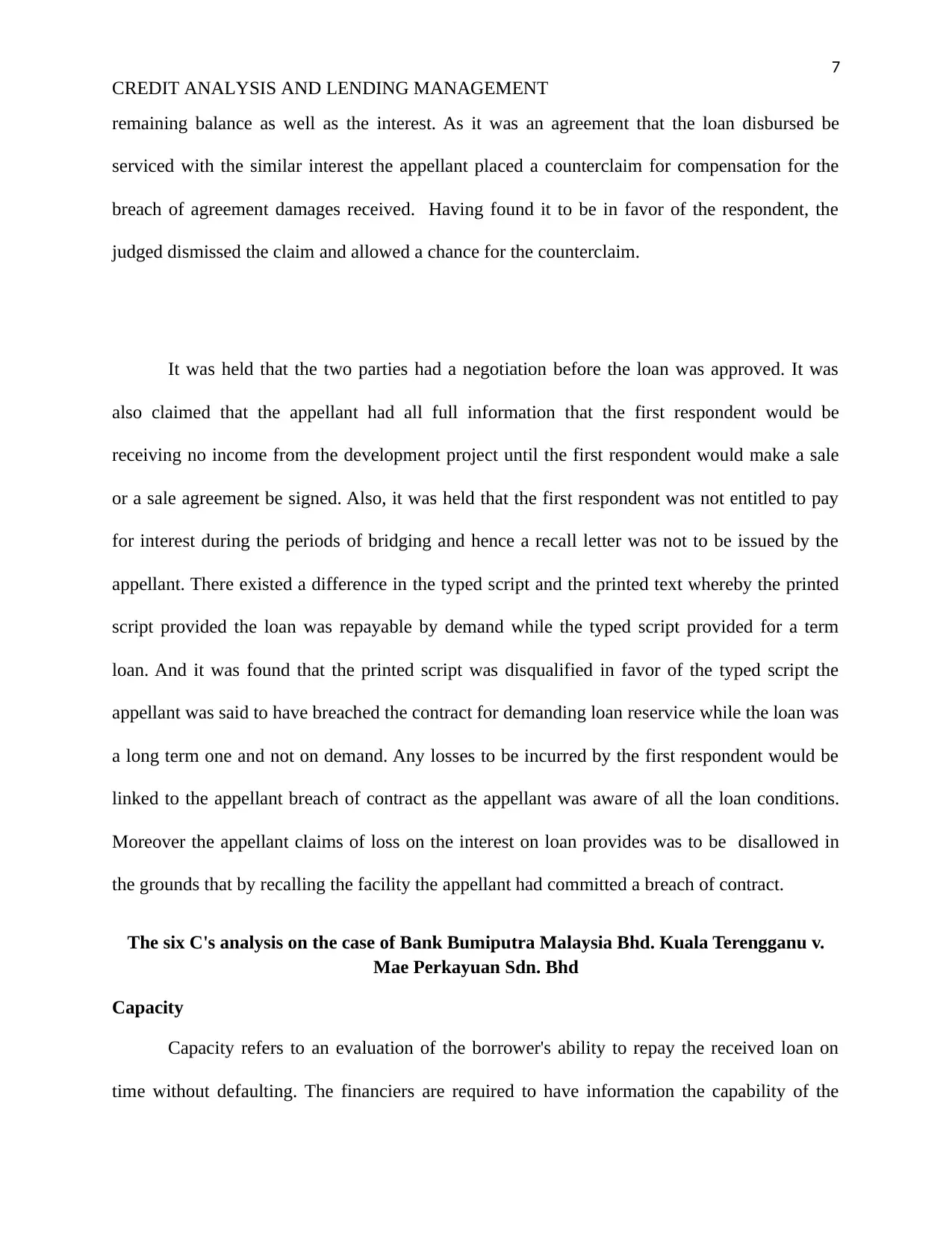
7
CREDIT ANALYSIS AND LENDING MANAGEMENT
remaining balance as well as the interest. As it was an agreement that the loan disbursed be
serviced with the similar interest the appellant placed a counterclaim for compensation for the
breach of agreement damages received. Having found it to be in favor of the respondent, the
judged dismissed the claim and allowed a chance for the counterclaim.
It was held that the two parties had a negotiation before the loan was approved. It was
also claimed that the appellant had all full information that the first respondent would be
receiving no income from the development project until the first respondent would make a sale
or a sale agreement be signed. Also, it was held that the first respondent was not entitled to pay
for interest during the periods of bridging and hence a recall letter was not to be issued by the
appellant. There existed a difference in the typed script and the printed text whereby the printed
script provided the loan was repayable by demand while the typed script provided for a term
loan. And it was found that the printed script was disqualified in favor of the typed script the
appellant was said to have breached the contract for demanding loan reservice while the loan was
a long term one and not on demand. Any losses to be incurred by the first respondent would be
linked to the appellant breach of contract as the appellant was aware of all the loan conditions.
Moreover the appellant claims of loss on the interest on loan provides was to be disallowed in
the grounds that by recalling the facility the appellant had committed a breach of contract.
The six C's analysis on the case of Bank Bumiputra Malaysia Bhd. Kuala Terengganu v.
Mae Perkayuan Sdn. Bhd
Capacity
Capacity refers to an evaluation of the borrower's ability to repay the received loan on
time without defaulting. The financiers are required to have information the capability of the
CREDIT ANALYSIS AND LENDING MANAGEMENT
remaining balance as well as the interest. As it was an agreement that the loan disbursed be
serviced with the similar interest the appellant placed a counterclaim for compensation for the
breach of agreement damages received. Having found it to be in favor of the respondent, the
judged dismissed the claim and allowed a chance for the counterclaim.
It was held that the two parties had a negotiation before the loan was approved. It was
also claimed that the appellant had all full information that the first respondent would be
receiving no income from the development project until the first respondent would make a sale
or a sale agreement be signed. Also, it was held that the first respondent was not entitled to pay
for interest during the periods of bridging and hence a recall letter was not to be issued by the
appellant. There existed a difference in the typed script and the printed text whereby the printed
script provided the loan was repayable by demand while the typed script provided for a term
loan. And it was found that the printed script was disqualified in favor of the typed script the
appellant was said to have breached the contract for demanding loan reservice while the loan was
a long term one and not on demand. Any losses to be incurred by the first respondent would be
linked to the appellant breach of contract as the appellant was aware of all the loan conditions.
Moreover the appellant claims of loss on the interest on loan provides was to be disallowed in
the grounds that by recalling the facility the appellant had committed a breach of contract.
The six C's analysis on the case of Bank Bumiputra Malaysia Bhd. Kuala Terengganu v.
Mae Perkayuan Sdn. Bhd
Capacity
Capacity refers to an evaluation of the borrower's ability to repay the received loan on
time without defaulting. The financiers are required to have information the capability of the
Secure Best Marks with AI Grader
Need help grading? Try our AI Grader for instant feedback on your assignments.
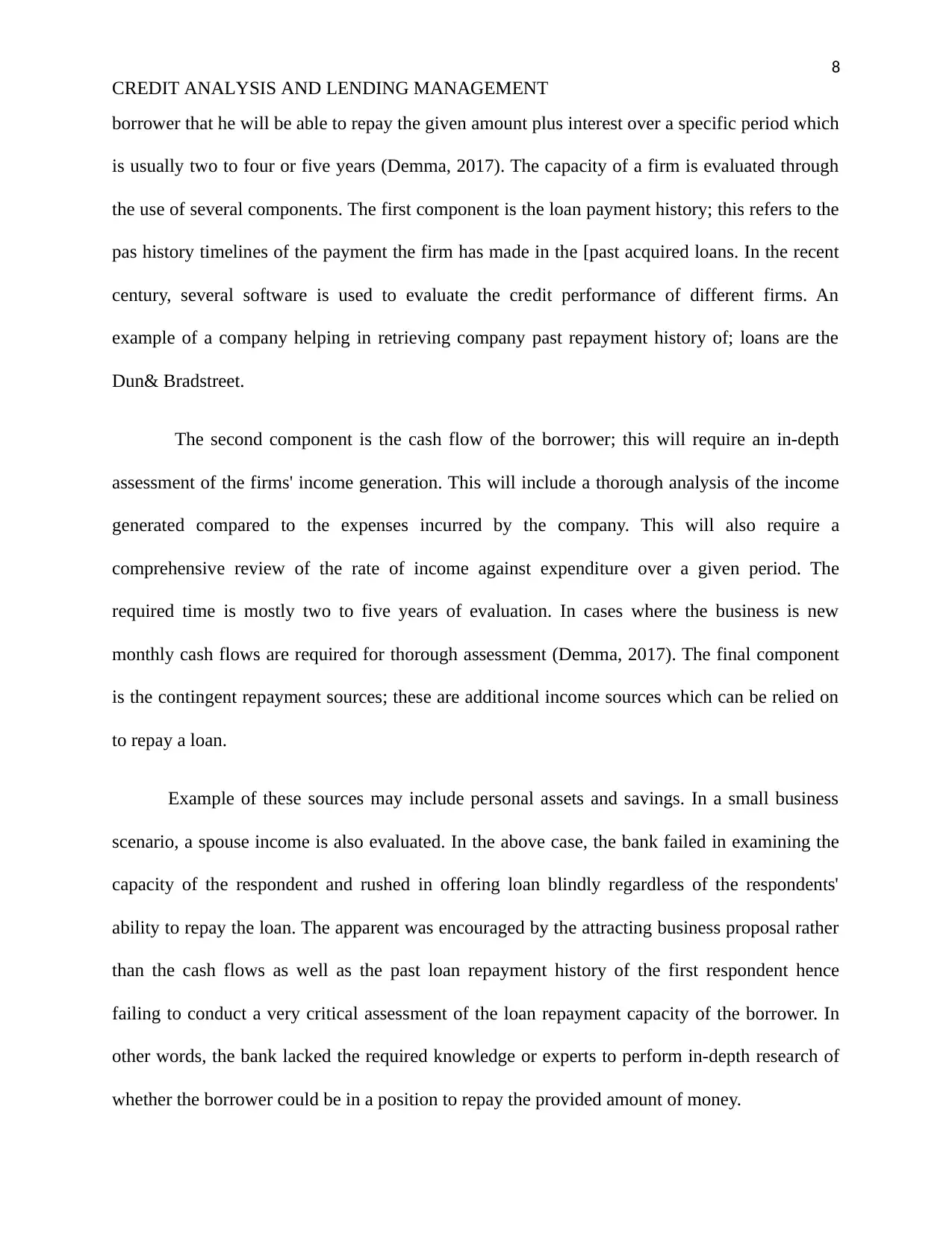
8
CREDIT ANALYSIS AND LENDING MANAGEMENT
borrower that he will be able to repay the given amount plus interest over a specific period which
is usually two to four or five years (Demma, 2017). The capacity of a firm is evaluated through
the use of several components. The first component is the loan payment history; this refers to the
pas history timelines of the payment the firm has made in the [past acquired loans. In the recent
century, several software is used to evaluate the credit performance of different firms. An
example of a company helping in retrieving company past repayment history of; loans are the
Dun& Bradstreet.
The second component is the cash flow of the borrower; this will require an in-depth
assessment of the firms' income generation. This will include a thorough analysis of the income
generated compared to the expenses incurred by the company. This will also require a
comprehensive review of the rate of income against expenditure over a given period. The
required time is mostly two to five years of evaluation. In cases where the business is new
monthly cash flows are required for thorough assessment (Demma, 2017). The final component
is the contingent repayment sources; these are additional income sources which can be relied on
to repay a loan.
Example of these sources may include personal assets and savings. In a small business
scenario, a spouse income is also evaluated. In the above case, the bank failed in examining the
capacity of the respondent and rushed in offering loan blindly regardless of the respondents'
ability to repay the loan. The apparent was encouraged by the attracting business proposal rather
than the cash flows as well as the past loan repayment history of the first respondent hence
failing to conduct a very critical assessment of the loan repayment capacity of the borrower. In
other words, the bank lacked the required knowledge or experts to perform in-depth research of
whether the borrower could be in a position to repay the provided amount of money.
CREDIT ANALYSIS AND LENDING MANAGEMENT
borrower that he will be able to repay the given amount plus interest over a specific period which
is usually two to four or five years (Demma, 2017). The capacity of a firm is evaluated through
the use of several components. The first component is the loan payment history; this refers to the
pas history timelines of the payment the firm has made in the [past acquired loans. In the recent
century, several software is used to evaluate the credit performance of different firms. An
example of a company helping in retrieving company past repayment history of; loans are the
Dun& Bradstreet.
The second component is the cash flow of the borrower; this will require an in-depth
assessment of the firms' income generation. This will include a thorough analysis of the income
generated compared to the expenses incurred by the company. This will also require a
comprehensive review of the rate of income against expenditure over a given period. The
required time is mostly two to five years of evaluation. In cases where the business is new
monthly cash flows are required for thorough assessment (Demma, 2017). The final component
is the contingent repayment sources; these are additional income sources which can be relied on
to repay a loan.
Example of these sources may include personal assets and savings. In a small business
scenario, a spouse income is also evaluated. In the above case, the bank failed in examining the
capacity of the respondent and rushed in offering loan blindly regardless of the respondents'
ability to repay the loan. The apparent was encouraged by the attracting business proposal rather
than the cash flows as well as the past loan repayment history of the first respondent hence
failing to conduct a very critical assessment of the loan repayment capacity of the borrower. In
other words, the bank lacked the required knowledge or experts to perform in-depth research of
whether the borrower could be in a position to repay the provided amount of money.
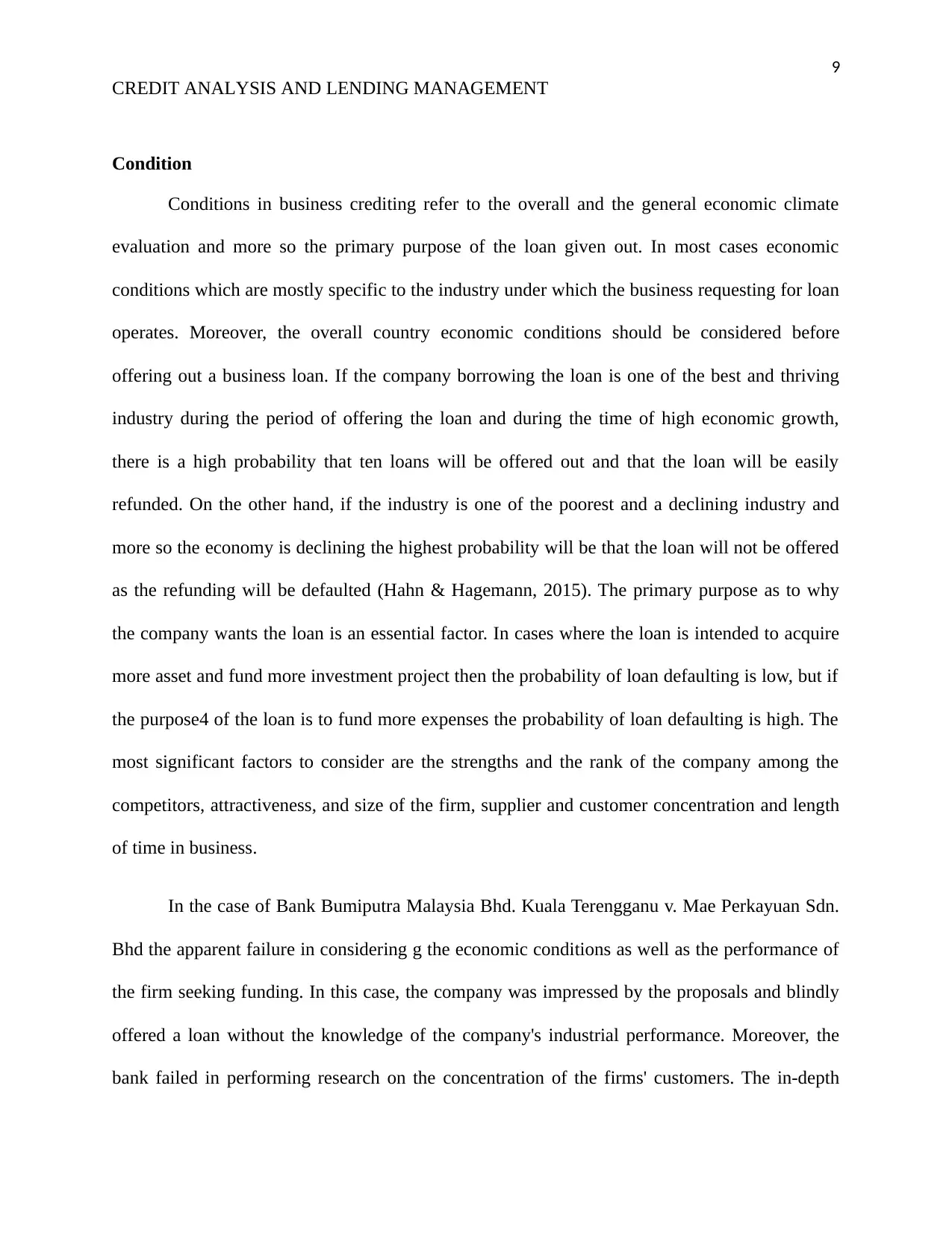
9
CREDIT ANALYSIS AND LENDING MANAGEMENT
Condition
Conditions in business crediting refer to the overall and the general economic climate
evaluation and more so the primary purpose of the loan given out. In most cases economic
conditions which are mostly specific to the industry under which the business requesting for loan
operates. Moreover, the overall country economic conditions should be considered before
offering out a business loan. If the company borrowing the loan is one of the best and thriving
industry during the period of offering the loan and during the time of high economic growth,
there is a high probability that ten loans will be offered out and that the loan will be easily
refunded. On the other hand, if the industry is one of the poorest and a declining industry and
more so the economy is declining the highest probability will be that the loan will not be offered
as the refunding will be defaulted (Hahn & Hagemann, 2015). The primary purpose as to why
the company wants the loan is an essential factor. In cases where the loan is intended to acquire
more asset and fund more investment project then the probability of loan defaulting is low, but if
the purpose4 of the loan is to fund more expenses the probability of loan defaulting is high. The
most significant factors to consider are the strengths and the rank of the company among the
competitors, attractiveness, and size of the firm, supplier and customer concentration and length
of time in business.
In the case of Bank Bumiputra Malaysia Bhd. Kuala Terengganu v. Mae Perkayuan Sdn.
Bhd the apparent failure in considering g the economic conditions as well as the performance of
the firm seeking funding. In this case, the company was impressed by the proposals and blindly
offered a loan without the knowledge of the company's industrial performance. Moreover, the
bank failed in performing research on the concentration of the firms' customers. The in-depth
CREDIT ANALYSIS AND LENDING MANAGEMENT
Condition
Conditions in business crediting refer to the overall and the general economic climate
evaluation and more so the primary purpose of the loan given out. In most cases economic
conditions which are mostly specific to the industry under which the business requesting for loan
operates. Moreover, the overall country economic conditions should be considered before
offering out a business loan. If the company borrowing the loan is one of the best and thriving
industry during the period of offering the loan and during the time of high economic growth,
there is a high probability that ten loans will be offered out and that the loan will be easily
refunded. On the other hand, if the industry is one of the poorest and a declining industry and
more so the economy is declining the highest probability will be that the loan will not be offered
as the refunding will be defaulted (Hahn & Hagemann, 2015). The primary purpose as to why
the company wants the loan is an essential factor. In cases where the loan is intended to acquire
more asset and fund more investment project then the probability of loan defaulting is low, but if
the purpose4 of the loan is to fund more expenses the probability of loan defaulting is high. The
most significant factors to consider are the strengths and the rank of the company among the
competitors, attractiveness, and size of the firm, supplier and customer concentration and length
of time in business.
In the case of Bank Bumiputra Malaysia Bhd. Kuala Terengganu v. Mae Perkayuan Sdn.
Bhd the apparent failure in considering g the economic conditions as well as the performance of
the firm seeking funding. In this case, the company was impressed by the proposals and blindly
offered a loan without the knowledge of the company's industrial performance. Moreover, the
bank failed in performing research on the concentration of the firms' customers. The in-depth
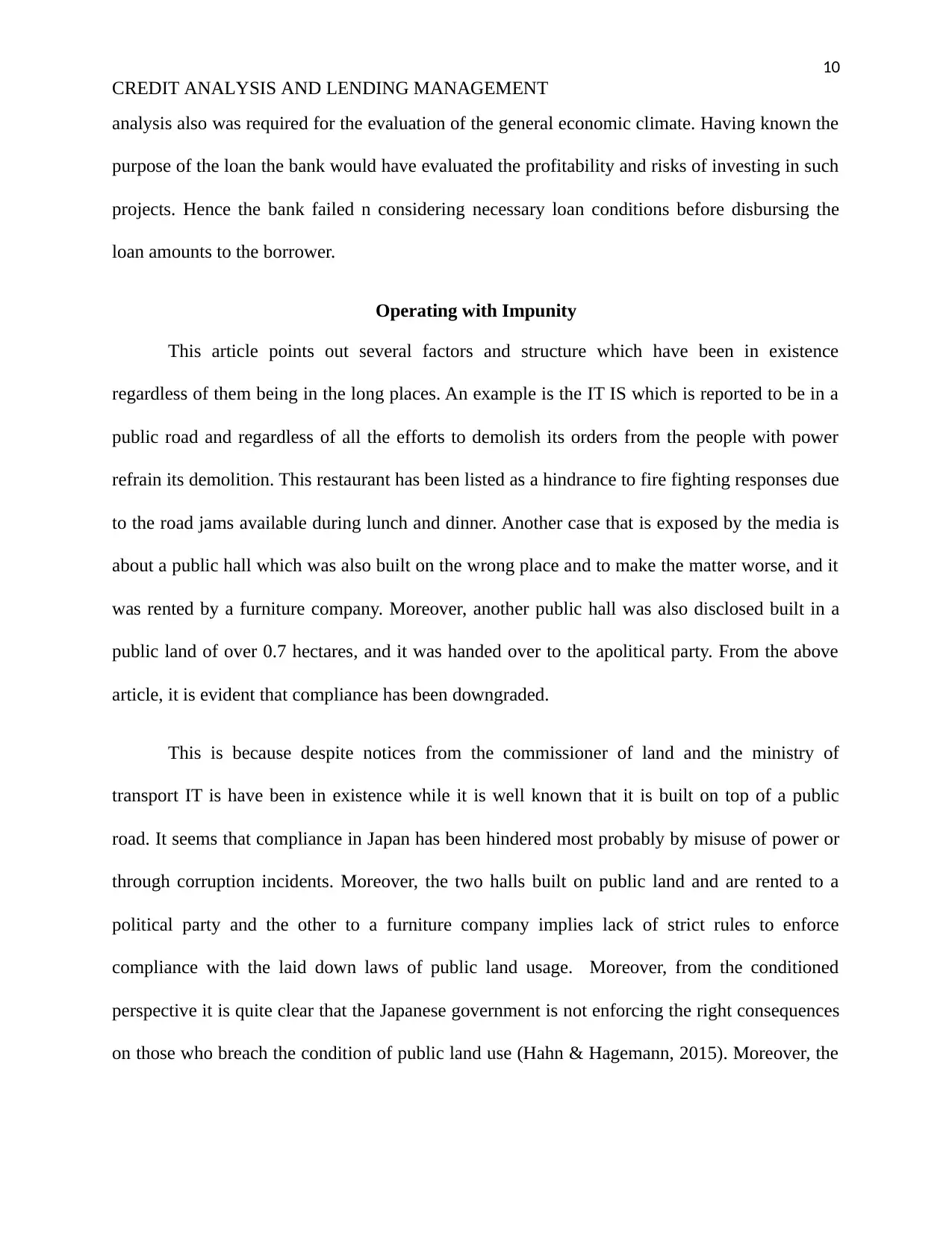
10
CREDIT ANALYSIS AND LENDING MANAGEMENT
analysis also was required for the evaluation of the general economic climate. Having known the
purpose of the loan the bank would have evaluated the profitability and risks of investing in such
projects. Hence the bank failed n considering necessary loan conditions before disbursing the
loan amounts to the borrower.
Operating with Impunity
This article points out several factors and structure which have been in existence
regardless of them being in the long places. An example is the IT IS which is reported to be in a
public road and regardless of all the efforts to demolish its orders from the people with power
refrain its demolition. This restaurant has been listed as a hindrance to fire fighting responses due
to the road jams available during lunch and dinner. Another case that is exposed by the media is
about a public hall which was also built on the wrong place and to make the matter worse, and it
was rented by a furniture company. Moreover, another public hall was also disclosed built in a
public land of over 0.7 hectares, and it was handed over to the apolitical party. From the above
article, it is evident that compliance has been downgraded.
This is because despite notices from the commissioner of land and the ministry of
transport IT is have been in existence while it is well known that it is built on top of a public
road. It seems that compliance in Japan has been hindered most probably by misuse of power or
through corruption incidents. Moreover, the two halls built on public land and are rented to a
political party and the other to a furniture company implies lack of strict rules to enforce
compliance with the laid down laws of public land usage. Moreover, from the conditioned
perspective it is quite clear that the Japanese government is not enforcing the right consequences
on those who breach the condition of public land use (Hahn & Hagemann, 2015). Moreover, the
CREDIT ANALYSIS AND LENDING MANAGEMENT
analysis also was required for the evaluation of the general economic climate. Having known the
purpose of the loan the bank would have evaluated the profitability and risks of investing in such
projects. Hence the bank failed n considering necessary loan conditions before disbursing the
loan amounts to the borrower.
Operating with Impunity
This article points out several factors and structure which have been in existence
regardless of them being in the long places. An example is the IT IS which is reported to be in a
public road and regardless of all the efforts to demolish its orders from the people with power
refrain its demolition. This restaurant has been listed as a hindrance to fire fighting responses due
to the road jams available during lunch and dinner. Another case that is exposed by the media is
about a public hall which was also built on the wrong place and to make the matter worse, and it
was rented by a furniture company. Moreover, another public hall was also disclosed built in a
public land of over 0.7 hectares, and it was handed over to the apolitical party. From the above
article, it is evident that compliance has been downgraded.
This is because despite notices from the commissioner of land and the ministry of
transport IT is have been in existence while it is well known that it is built on top of a public
road. It seems that compliance in Japan has been hindered most probably by misuse of power or
through corruption incidents. Moreover, the two halls built on public land and are rented to a
political party and the other to a furniture company implies lack of strict rules to enforce
compliance with the laid down laws of public land usage. Moreover, from the conditioned
perspective it is quite clear that the Japanese government is not enforcing the right consequences
on those who breach the condition of public land use (Hahn & Hagemann, 2015). Moreover, the
Paraphrase This Document
Need a fresh take? Get an instant paraphrase of this document with our AI Paraphraser
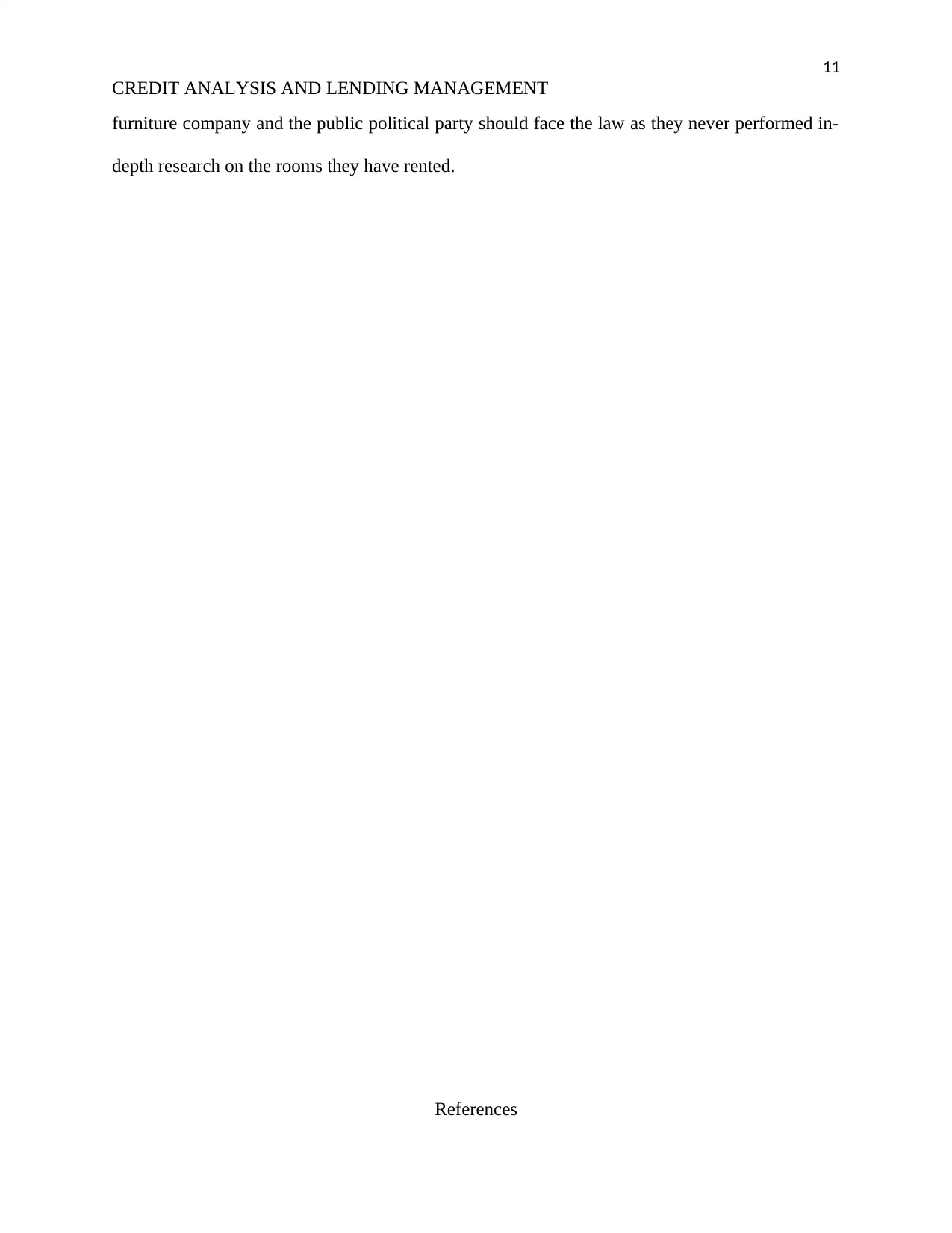
11
CREDIT ANALYSIS AND LENDING MANAGEMENT
furniture company and the public political party should face the law as they never performed in-
depth research on the rooms they have rented.
References
CREDIT ANALYSIS AND LENDING MANAGEMENT
furniture company and the public political party should face the law as they never performed in-
depth research on the rooms they have rented.
References
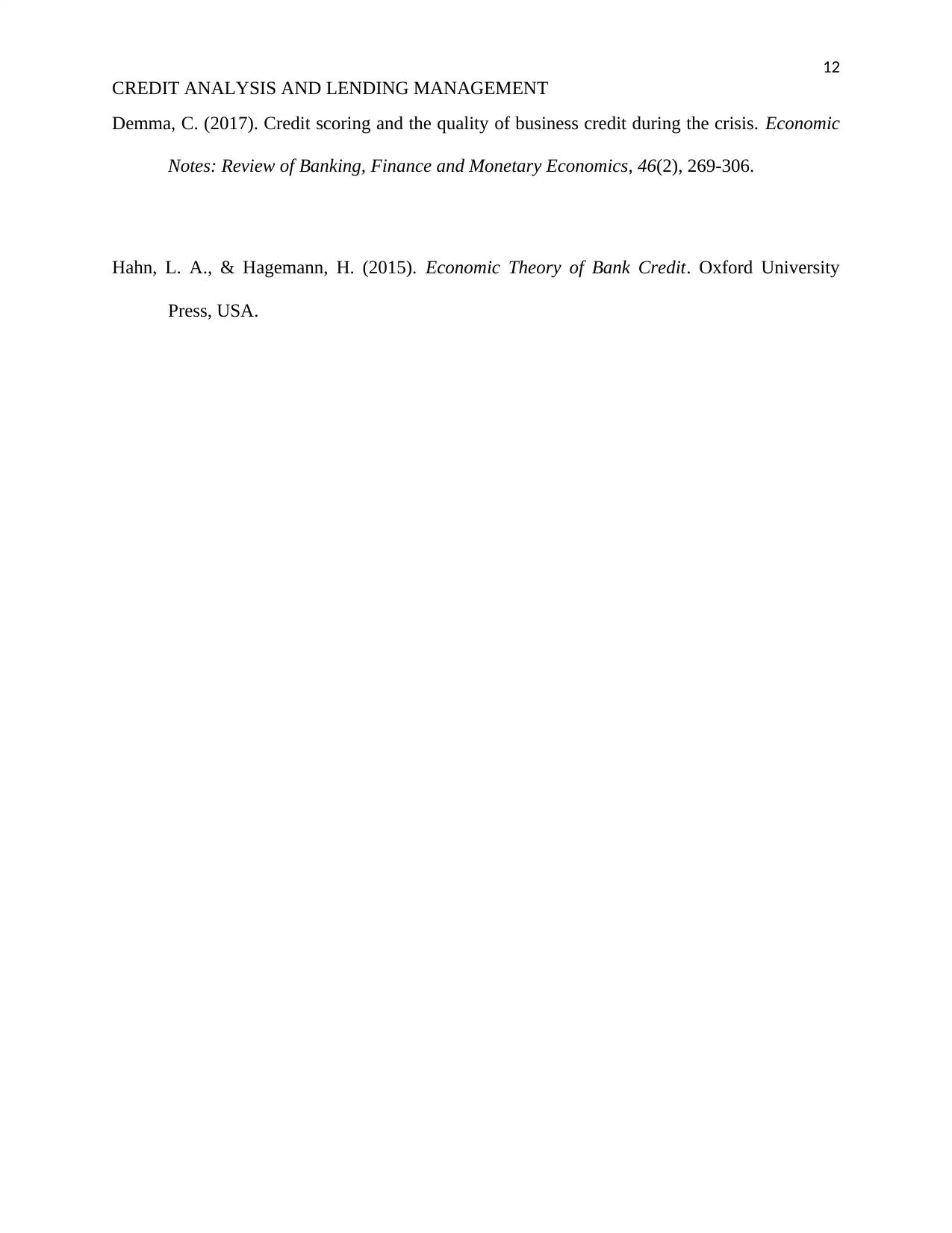
12
CREDIT ANALYSIS AND LENDING MANAGEMENT
Demma, C. (2017). Credit scoring and the quality of business credit during the crisis. Economic
Notes: Review of Banking, Finance and Monetary Economics, 46(2), 269-306.
Hahn, L. A., & Hagemann, H. (2015). Economic Theory of Bank Credit. Oxford University
Press, USA.
CREDIT ANALYSIS AND LENDING MANAGEMENT
Demma, C. (2017). Credit scoring and the quality of business credit during the crisis. Economic
Notes: Review of Banking, Finance and Monetary Economics, 46(2), 269-306.
Hahn, L. A., & Hagemann, H. (2015). Economic Theory of Bank Credit. Oxford University
Press, USA.
1 out of 12
Your All-in-One AI-Powered Toolkit for Academic Success.
+13062052269
info@desklib.com
Available 24*7 on WhatsApp / Email
![[object Object]](/_next/static/media/star-bottom.7253800d.svg)
Unlock your academic potential
© 2024 | Zucol Services PVT LTD | All rights reserved.

